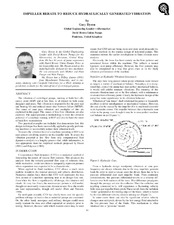| dc.contributor.other | International Pump Users Symposium (22nd : 2005) | |
| dc.creator | Dyson, Gary | |
| dc.date.accessioned | 2017-10-05T15:23:39Z | |
| dc.date.available | 2017-10-05T15:23:39Z | |
| dc.date.issued | 2005 | |
| dc.identifier.uri | https://hdl.handle.net/1969.1/163960 | |
| dc.description | Lecture | en |
| dc.description | pg. 10 | en |
| dc.description.abstract | The vibration of centrifugal pumps, running at both best efficiency point (BEP) and at low flow, is of interest to both pump designers and users. This vibration is responsible for the poor seal and bearing life and reduced mean time between failure (MTFB). The cause of vane pass vibration and multiples of this are explained in this paper. The causes of low flow vibrations are also explored. The paper presents a methodology to limit the vibration potential of a machine running at BEP and also to limit the onset of backflow recirculation. Two practical examples are included that demonstrate how this design technique has been successfully applied to poorly performing machines to successfully reduce their vibration levels. To assess the vibration level of a machine operating at BEP is an easy process involving analysis on the impeller only. To asses the vibration potential at low flow from only computational fluid dynamics analysis is a lengthy process that, while informative, is less appropriate than the empirical methods proposed by Fraser (1981) and Palgrave (1985) | en |
| dc.format.medium | Electronic | en |
| dc.format.mimetype | application/pdf | |
| dc.language.iso | en | |
| dc.publisher | Texas A&M University. Turbomachinery Laboratories | |
| dc.relation.ispartof | Proceedings of the 22nd International Pump Users Symposium | en |
| dc.subject.lcsh | Pumping machinery | en |
| dc.title | Impeller Rerate To Reduce Hydraulically Generated Vibration | en |
| dc.type.genre | Presentation | en |
| dc.type.material | Text | en |
| dc.identifier.doi | https://doi.org/10.21423/R1X961 | |


